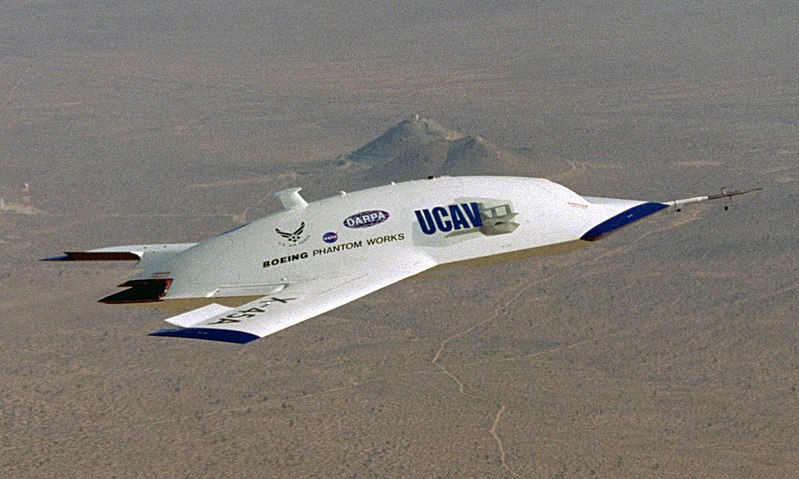BOEING X-45 AND PHANTOM RAY
The Boeing X-45 unmanned combat air vehicle is a concept demonstrator for a next generation of completely autonomous military aircraft, developed by Boeing's Phantom Works. Manufactured by Boeing Integrated Defense Systems, the X-45 was a part of DARPA's J-UCAS project.
Boeing developed the X-45 from research gathered during the development of the Bird of Prey. The X-45 features an extremely low-profile dorsal intake placed near the leading edge of the aircraft. The center fuselage is blended into a swept lambda wing, with a small exhaust outlet. It has no vertical control surfaces — split ailerons near each wingtip function as asymmetric air brakes, providing rudder control, much as in Northrop's flying wings.




Boeing developed the X-45 from research gathered during the development of the Bird of Prey. The X-45 features an extremely low-profile dorsal intake placed near the leading edge of the aircraft. The center fuselage is blended into a swept lambda wing, with a small exhaust outlet. It has no vertical control surfaces — split ailerons near each wingtip function as asymmetric air brakes, providing rudder control, much as in Northrop's flying wings.
Boeing Bird of Prey

The Boeing Bird of Prey was a black project aircraft, intended to demonstrate stealth technology. It was developed by McDonnell Douglas and Boeing in the 1990s. As an internal project, this aircraft was not given an X-plane designation. There are no public plans to make this a production aircraft. It is characterized as a technology demonstrator.
The shape is aerodynamically stable enough to be flown without computer correction. Its aerodynamic stability is due to the same mechanisms found incanard aircraft such as the VariEze, the lift normally generated by the canards being provided by the chines (which therefore keeps the nose from sinking). This configuration, which can be stable without a horizontal tailplane and a conventional vertical rudder, is now a standard in modern stealth unmanned aerial vehicles such as the X-45 and X-47, tailless aircraft which use drag rudders (asymmetrically-used wingtip airbrakes) for rudder control
X-45A

Boeing built two of the model X-45A; both were scaled-down proof-of-concept aircraft. The first was completed by Boeing's Phantom Works in September 2000. The goal of the X-45A technology demonstrator program was to develop the technologies needed to "conduct suppression of enemy air defense missions with unmanned combat air vehicles."The first generation of unmanned combat air vehicles are primarily planned for air-to-ground roles with defensive air-to-air capabilities coupled with significant remote piloting.
On February 4, 2005, on their 50th flight, the two X-45As took off into a patrol pattern and were then alerted to the presence of a target. The X-45As then autonomously determined which vehicle held the optimum position, weapons (notional), and fuel load to properly attack the target. After making that decision, one of the X-45As changed course and the pilot-operator allowed it to attack the simulated antiaircraft emplacement. Following a successful strike, another simulated threat, this time disguised, emerged and was subsequently destroyed by the second X-45A. This demonstrated the ability of these vehicles to work autonomously as a team and manage their resources, as well as to engage previously-undetected targets, which is significantly harder than following a predetermined attack path.
X-45B/C

The larger X-45B design was modified to have even more fuel capacity and three times greater combat range, becoming the X-45C. Each wing's leading edge spans from the nose to the wingtip, giving the aircraft more wing area, and a planform very similar to the B-2 Spirits
As of March 2, 2006, the US Air Force has decided not to continue with the X-45 project. However, Boeing submitted a proposal to the Navy for a carrier based demonstrator version of the X-45, designated the X-45N.
X-45N
The X-45N was Boeing's proposal to the Navy's Unmanned Combat Air Systems demonstration project. When it became known that the US Air Force would end funding to the Joint Unmanned Combat Air System program (which included the X-45 and X-47), the US Navy started its own UCAS program.
The software Boeing developed to allow the X-45N to land and takeoff autonomously on aircraft carriers has recently been installed on the first F/A-18F, which has used it to perform autonomous approaches. All autonomous approaches ended with a wave-off by design. This Super Hornet is expected to be able to hook the carrier's arrester cables autonomously by the 2009 timeframe,setting the stage for carrier-borne UAV operations.
Phantom Ray

The Boeing Phantom Ray is a stealth unmanned combat air vehicle being developed by Boeing using company funds. The Phantom Ray is a demonstrator aircraft, about the size of a fighter that will conduct a program of test flights involving surveillance, ground attack and autonomous aerial refueling missions
The demonstrator aircraft is to perform 10 test flights over six months, supporting missions such as intelligence, surveillance and reconnaissance; suppression of enemy air defenses; electronic attack; hunter/killer; and autonomous aerial refueling. Boeing anticipates that the Phantom Ray will be the first of a series of new prototype aircraft.
Comments
Post a Comment